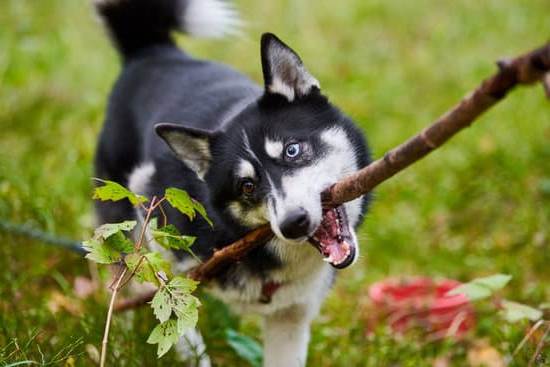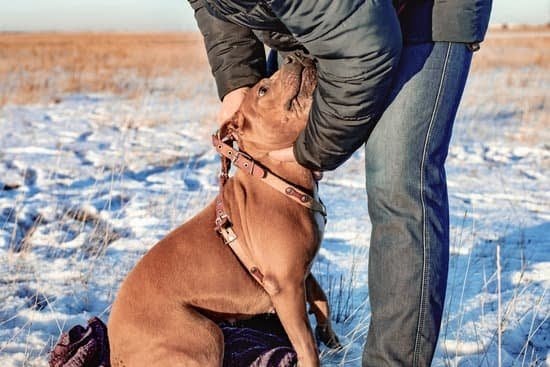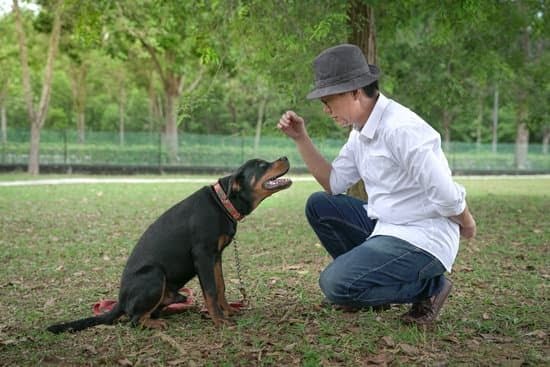Training your dog is essential for a harmonious and rewarding relationship between you and your furry friend. Not only does it enhance their behavior, but it also improves their overall well-being. In this introductory section, we will delve into the benefits of dog training and how it strengthens the bond between an owner and their canine companion.
Firstly, training your dog provides numerous advantages. It teaches them proper manners, which allows them to integrate seamlessly into your household and society. From basic obedience commands like sit and stay to more advanced skills like leash walking or recall, training instills discipline in your dog’s behavior. This enables you to have better control over them in various situations.
Additionally, training fosters mental stimulation for your dog. Dogs are intelligent creatures that thrive on learning new things. Through training sessions, they engage their minds and prevent boredom or destructive behaviors that may arise from a lack of mental stimulation.
Moreover, the process of training creates a stronger bond between you and your canine companion. As you guide them through learning new skills, they develop trust in you as their leader while building confidence in themselves. Training reinforces positive communication between both parties, making it easier for you to understand each other’s needs and desires.
By investing time and effort into training your dog, you are not only improving their behavior but also nurturing a fulfilling relationship based on trust, respect, and clear communication. So let’s dive deeper into understanding your dog’s behavior to lay the foundation for successful training.
Understanding Your Dog’s Behavior
Understanding your dog’s behavior is a crucial step in training them effectively. By gaining insights into their natural instincts and breed-specific behaviors, you can tailor your training methods to suit their needs. This section will delve into the importance of understanding your dog’s behavior, identifying common behavioral issues, and their potential causes.
Dogs have a myriad of natural instincts that guide their behavior. For example, herding dogs may have a strong drive to chase and round-up other animals, while terriers may have a natural instinct to dig. Understanding these instincts can help you anticipate certain behaviors and design training exercises that redirect or channel these instincts appropriately.
Breed-specific behavior traits also play a significant role in shaping your dog’s behavior. Different breeds were selectively bred for specific purposes, such as hunting, guarding, or companionship. These traits can influence how your dog responds to training and the types of challenges you may face. By researching your dog’s breed characteristics and consulting with professionals, you can gain valuable insights into how best to approach their training.
Additionally, it is essential to recognize common behavioral issues that dogs often exhibit. Causes for problem behaviors like barking excessively or exhibiting aggression can include fear, anxiety, lack of socialization, or even medical conditions. Recognizing these underlying causes will help you address them directly through targeted training techniques that address the root of the issue rather than just managing the symptoms.
By understanding your dog’s behavior from both an instinctual and breed-specific standpoint, you can approach their training with greater insight and effectiveness. With this knowledge in hand, you’ll be better equipped to identify potential challenges and create tailored strategies for addressing any behavioral issues that may arise during the training process.
Setting Realistic Training Goals
When embarking on the journey of training your dog, it is crucial to set realistic goals that take into account your dog’s unique abilities, temperament, and learning pace. It can be tempting to expect immediate progress and perfection from your furry friend, but it is important to remember that each dog is an individual with their own strengths and challenges. By setting achievable goals, you can create a positive training experience for both you and your dog.
One key aspect of setting realistic training goals is understanding that each dog learns at their own pace. Some dogs may pick up new commands quickly while others may require more time and repetition. This variation in learning speed does not indicate a lack of intelligence or willingness on the part of the dog.
It simply means that they need more time to understand and internalize the desired behavior. As an owner, it is essential to be patient, provide consistent reinforcement, and celebrate small victories along the way.
To set achievable goals for your dog’s training, consider breaking down complex behaviors into smaller steps or tasks. For example, if you want your dog to learn how to stay on command, start by teaching them to sit or lie down first.
Gradually increase the duration of the stay as they become more comfortable with the concept. This approach allows your dog to build confidence by mastering one step at a time and prevents overwhelming them with advanced commands too soon.
By setting realistic training goals for your dog, you pave the way for successful training sessions that foster progress and build a strong foundation for future learning. Remember that consistency, patience, and positive reinforcement are key components of achieving these goals. With dedication and a clear understanding of what can be expected from your four-legged companion, you will be able to embark on a rewarding training journey together.
| Key Points |
|---|
| Set realistic goals that take into account your dog’s unique abilities and learning pace. |
| Understand that each dog learns at their own pace and be patient throughout the training process. |
| Break down complex behaviors into smaller, attainable steps to build confidence and prevent overwhelm. |
Establishing a Positive Environment for Training
In order to effectively train your dog, it is crucial to establish a positive and calm environment. Creating this environment will not only enhance the training experience but also increase the chances of success in shaping your dog’s behavior. Here are some tips to help you establish a positive environment for training:
- Choose the right time and place: Find a quiet and distraction-free area in your home where you can conduct training sessions with your dog. It could be a designated spot in your living room or even your backyard. Ensure that there are minimal noises or distractions that could divert your dog’s attention.
- Use positive reinforcement: Positive reinforcement is key when establishing an encouraging environment for training. Rewarding good behavior with treats, praise, or playtime will motivate your dog to repeat the desired actions. Remember to be consistent and reward instantly after a correct response.
- Select appropriate training tools: There are various tools that can contribute to a positive learning atmosphere during training sessions. For example, using clicker training can help establish clear communication with your dog and mark desirable behaviors. Additionally, having durable and comfortable equipment such as leashes, harnesses, and treat pouches can make the overall experience more pleasant for both you and your canine companion.
It’s important to note that creating a positive environment isn’t limited to just designated training sessions; it extends to everyday interactions with your dog as well. Consistently using positive reinforcement techniques throughout the day will reinforce good behavior on an ongoing basis.
By establishing a positive environment for training, you set yourself up for successful results in shaping your dog’s behavior. A calm and encouraging atmosphere will make both you and your furry friend eager participants in the training process, leading to a stronger bond between you two.
Basic Obedience Commands for Beginners
When it comes to training your dog, teaching them basic obedience commands is an essential starting point. These commands not only ensure safety and control but also lay the foundation for more advanced training. In this section, we will provide step-by-step instructions for teaching fundamental obedience commands such as sit, stay, and come.
Sit:
- Start by holding a treat close to your dog’s nose.
- Slowly move the treat up and back over their head, causing their bottom to lower.
- Once they are in a sitting position, say “sit” and immediately give them the treat.
- Repeat this process several times a day until your dog understands the command without needing the treat as a lure.
Stay:
- Begin with your dog in a sitting position.
- Hold up your palm towards their face while saying “stay” in a firm voice.
- Take a step backward and wait for a few seconds before returning and giving them praise or a treat.
- Gradually increase the distance and duration of the stay command, always rewarding your dog for successful stays.
Come:
- Attach a long leash to your dog’s collar and crouch down while opening your arms wide.
- Using an enthusiastic tone, say “come” while gently pulling on the leash.
- When your dog reaches you, reward them with praise and treats.
- Practice in various environments gradually allowing more freedom of movement by letting go of the leash or practicing off-leash when appropriate.
Consistency is key in training these basic obedience commands. Always use the same verbal cues and rewards so that your dog associates them correctly. It is important to reinforce each command with positive reinforcement such as treats, praise, or playtime to motivate your dog to continue obeying.
In some cases, you may encounter challenges during the training process. If your dog is struggling to understand a certain command or is resistant, try breaking it down into smaller steps or seek professional advice from a dog trainer or behaviorist.
Remember, training should be a fun and positive experience for both you and your dog. Be patient and set realistic expectations as each dog learns at their own pace. With practice and consistency, your dog will become proficient in these basic obedience commands, creating a strong foundation for further training endeavors.
Using Positive Reinforcement Techniques
Positive reinforcement is a highly effective technique in training dogs and can greatly enhance the learning process. This section will provide an explanation of positive reinforcement and its effectiveness, discuss various methods of rewarding good behavior, and offer tips on finding the right rewards for your dog.
The Concept of Positive Reinforcement
Positive reinforcement involves rewarding your dog for exhibiting desired behaviors. Instead of focusing on punishing or correcting unwanted behaviors, positive reinforcement focuses on encouraging and reinforcing the behaviors you want to see more of. By rewarding your dog with something they find enjoyable, such as treats, praise, or playtime, you are increasing the likelihood that they will repeat those behaviors in the future.
Studies have shown that positive reinforcement is not only highly effective but also helps to build a strong bond between you and your dog. It creates a positive association with training sessions, making them enjoyable for both you and your furry companion. This type of training also boosts their confidence and self-esteem, leading to a happier and well-rounded dog.
Methods of Rewarding Your Dog’s Good Behavior
When using positive reinforcement techniques, it is important to choose rewards that are meaningful and motivating for your dog. Every dog has their own preferences when it comes to rewards, so it may take some trial and error to find what works best for them. Some common types of rewards include:
- Treats: Food treats are often highly motivating for dogs. Choose small, soft treats that are easy to chew and digest quickly.
- Verbal praise: Dogs crave attention from their owners, so verbal praise in the form of enthusiastic words and an upbeat tone can be very rewarding.
- Toys: Many dogs love playing with toys as a reward. Use toys that are interactive and engaging to keep them interested.
- Petting or belly rubs: Physical affection can be a powerful reward for many dogs who enjoy touch and attention.
Finding the Right Rewards for Your Dog
Experiment with different types of rewards to determine what your dog responds to best. Some dogs may be food-motivated, while others may prefer playtime or praise. Pay close attention to your dog’s reaction and enthusiasm when using different rewards. If they show more interest in treats, focus on finding a variety of tasty treats that they find irresistible. If they are more toy-oriented, invest in toys that stimulate their natural instincts or provide mental enrichment.
Remember to keep rewards consistent and use them immediately after your dog exhibits the desired behavior. This helps them make a clear connection between their actions and the reward, reinforcing the behavior you want to encourage. As your dog progresses in their training, you can gradually decrease the frequency of treats or other tangible rewards and rely more on verbal praise and affection.
By using positive reinforcement techniques effectively, you can create a positive and engaging training experience for both you and your dog. Each successful training session will strengthen the bond between you two and bring you closer to achieving your training goals.
Addressing Behavioral Issues through Training
Behavioral issues are common among dogs, but through effective training, these issues can be addressed and resolved. By addressing behavioral issues, you can create a more harmonious relationship with your dog and ensure their overall well-being. In this section, we will discuss common behavioral problems such as barking, jumping, or pulling on the leash and provide strategies for correcting them through training.
One of the most common behavioral issues is excessive barking. Dogs bark for various reasons, including fear, boredom, or seeking attention. To address excessive barking, it’s important to understand the underlying cause and then use appropriate training techniques. One effective technique is teaching your dog the “quiet” command.
Start by saying “quiet” in a calm but firm voice whenever your dog starts barking excessively. Then wait for a moment of silence before praising them and rewarding them with treats or praise. Consistency is key in reinforcing this behavior.
Jumping on people can be another behavioral issue that needs to be addressed through training. Dogs often jump to seek attention or simply out of excitement when greeting people. To discourage jumping behavior, teach your dog an alternative behavior such as “sit” or “down.” When someone approaches, ask your dog to sit instead of jumping up. Reward the sitting behavior with treats or praise. Over time, your dog will learn that sitting leads to positive reinforcement while jumping does not.
Pulling on the leash during walks is another common issue that can make walks uncomfortable for both dogs and their owners. To address this problem, leash training is essential. Start by using a properly fitted harness or collar that allows you control over your dog’s movements without causing harm or discomfort. Practice loose-leash walking by gently guiding your dog back to your side whenever they start pulling ahead. Reward them when they walk calmly beside you without pulling.
The Role of Socialization in Training
Socialization is a vital aspect of training for dogs, as it plays a significant role in their overall development and well-being. It involves exposing your dog to various people, animals, environments, and situations to help them become more confident and adaptable. This section will discuss the importance of socialization in a dog’s training journey, provide tips on how to introduce your dog to new experiences, and highlight the impact of socialization on preventing aggression and anxiety.
The Importance of Socialization
Socialization is crucial because it helps dogs develop the necessary skills to interact with their surroundings positively. By exposing them to different people, animals, and environments during their early stages of life, owners can prevent fear or aggression issues from developing later on. Socializing a dog allows them to become comfortable in unfamiliar situations, reducing anxiety levels and promoting better behavior.
Tips for Introducing Your Dog to New Experiences
Introducing your dog gradually to new environments and experiences is essential for successful socialization. Start by allowing your dog to encounter various sounds, sights, and smells at home before gradually exposing them to external stimuli. Take your time during outings; start with quiet places with fewer distractions and slowly progress towards busier locations. It’s crucial to closely monitor your dog’s reactions during these encounters and provide positive reinforcement when they exhibit calm behavior.
When introducing your dog to other animals or people, make sure the interactions are controlled initially and take place in a safe environment. Observe body language carefully, ensuring that both parties feel comfortable before increasing the intensity or duration of the interaction.
The Role of Socialization in Preventing Aggression and Anxiety
Proper socialization greatly reduces the likelihood of developing aggressive tendencies or anxiety disorders in dogs. When they are exposed early on to various stimuli such as different types of people or animals, they learn how to distinguish between potential threats and safe situations. This exposure helps them build confidence and trust in their owners’ ability to handle any situation, ultimately reducing anxiety levels.
Additionally, socialization improves a dog’s ability to interact positively with other animals and humans. Well-socialized dogs are less likely to display fear-based aggression or react negatively when faced with new experiences. This not only ensures the safety of others but also enhances the overall quality of life for both the dog and its owner.
Conclusion
In conclusion, training your dog is not only important for their behavior and well-being, but it also enhances the bond between you and your furry companion. Throughout this article, we have discussed the benefits of dog training, understanding your dog’s behavior, setting realistic goals, establishing a positive training environment, teaching basic obedience commands, utilizing positive reinforcement techniques, addressing behavioral issues, and the role of socialization in training.
As you embark on this training journey with your dog, it is essential to take a moment to reflect on the progress that has been made. Celebrate every small achievement and milestone reached along the way. Remember that training takes time and patience; each dog learns at their own pace. Stay consistent in reinforcing behaviors and continue practicing regularly.
It is important to recognize that training is an ongoing process. Even after achieving desired results or addressing specific behavioral issues, it is crucial to continue reinforcing those behaviors consistently. This will help maintain the progress made and ensure a happy and healthy relationship between you and your dog.
Ultimately, a well-trained dog brings joy and peace into both your lives. The effort put into training will be rewarded with a strong connection built on trust and mutual understanding. So keep up the good work, stay committed to the training journey, and enjoy watching your dog flourish as they learn new skills and behaviors.
Frequently Asked Questions
How do you train a dog for beginners?
Training a dog for beginners requires patience, consistency, and positive reinforcement. It is important to start with basic commands such as sit, stay, and come. Begin by using treats or rewards to motivate the dog to follow these commands.
As you progress, gradually reduce the dependence on treats and focus more on praise and positive reinforcement. Consistency is key in training- use the same commands consistently and make sure everyone in the household uses the same techniques. Additionally, it is important to keep training sessions short but regular to maintain the dog’s interest and avoid overwhelming them.
What is the fastest way to train a dog?
The fastest way to train a dog is by using positive reinforcement techniques coupled with consistency and repetition. Positive reinforcement involves rewarding desired behaviors rather than punishing unwanted ones. This can be done through verbal praise, treats, or playtime as a reward for performing a command correctly.
Consistency is crucial as it helps the dog understand what behaviors are expected from them consistently. By repeating training exercises regularly, the dog becomes familiar with the commands and learns faster.
What are the 5 golden rules of dog training?
There are several golden rules of dog training that can help improve communication between you and your pup:

Welcome to the blog! I am a professional dog trainer and have been working with dogs for many years. In this blog, I will be discussing various topics related to dog training, including tips, tricks, and advice. I hope you find this information helpful and informative. Thanks for reading!





